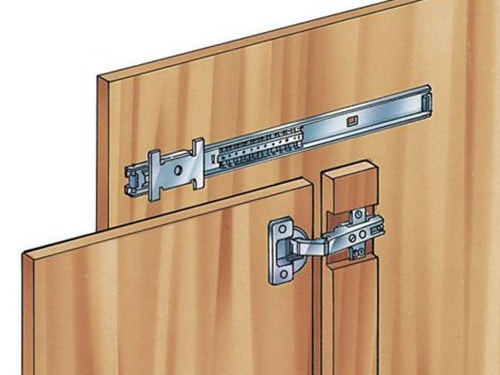Flipper Door FAQ
Want to build a cabinet with flipper-style hinges for the doors? We answer some commonly asked questions about these projects.
Which system is best for my application? There are quite a few options to sort through. Consider size and weight of the doors. The different systems we carry will list the weight they can handle and in some cases specify height parameters. Consider your door design also. Some systems have options for both inset or overlay doors. Back to TopWhat length slide do I need to choose? Two factors come in to play- the depth of the cabinet and the width of the door. You need to make sure that you'll have enough depth in the cabinet to fit the slide you select. Obviously, you can't fit a 24" long slide into a 20" space. There will be a strip of either wood or metal that goes from slide to slide that the hinges will attach to. This strip takes up some space, so the travel distance (this is the amount of the door that will disappear when moved back into the cabinet) will be less than the length of the slide. As an example, if you had a 18" wide door and a 18" long slide, then only 14 to 15" hinge of the door will go back into the cabinet. If you used a 22" long slide with a 18" wide door, then all of the door would disappear into the cabinet. Back to TopWhat is meant by inset door and overlay door? An inset door sits inside the face of the cabinet with the face of the door being flush with the face of the cabinet. On a flipper door system an overlay door will sit in front of the cabinet, with the hinge side of the door overlaying or covering up the front of the cabinet. Back to TopA cabinet is in essence a box. A face frame is a narrow piece of wood, usually about 2" wide that is attached to the front of this box, framing the opening where the doors go. Most flipper door systems are installed on cabinets without a face frame (this is called frameless construction). Back to TopWhat is meant by travel distance? This basically means the amount of door that will go back into the cabinet. If we have a 24" long slide with a travel distance equaling slide length minus 4-1/2", then the travel distance is 19-1/2". This means 19-1/2" of door will slide back into the cabinet when open. Back to TopDo I need to have the travel distance of the slide equal the width of my door? No, in fact in most cases you won't want to as you may have handles or knobs on the door. If you have a few inches sticking out when the door is opened, then the handles or knobs won't smash into the cabinet. In a case where you want the door to retract all the way when open, then you need to explore the use of a recessed pull of some sort into your design. Back to TopWhat if I have a taller door than the system recommends? Consider splitting the door into an upper and a lower door if possible. Or you might space the hinges in from the top and bottom of the door beyond the normal installation. If you decide to try this you will need to do more measuring and layout than the instructions will detail. Also, be sure not to exceed the per door weight rating recommend for the system. Back to TopAre these difficult to install? They can be complicated. Some systems are easier to install, but you will find that installing a system into a new cabinet is easier than trying to retro-fit to an existing cabinet as you won't have to worry about possibly re-fitting the doors or having to make replacement doors. Back to TopWhen a door gets larger it has a tendency to tip forward as you have the door open and are about to slide it back into the cabinet. This tendency is called racking. Some systems have features designed to counter this tendency to rack. Back to TopWhat is a follower strip or carrier strip? These terms are used interchangeably. These terms refer to the piece that goes from one slide to the other that the hinges are attached to. In some cases it is a wood piece that you make. In other cases it will be metal. Back to TopWhat if I have a door thicker than 3/4 inch? Most systems are designed for doors 3/4" thick. If you try to use a thicker door with these it will not work as the face of the door will sit out too far and/or it will scrape on the slides as the door is slide back into the cabinet. Back to TopCan the slides be cut down to a shorter length? No, they cannot be cut. Most systems use a ball bearing slide and you may lose the bearings if the ends are cut. Any alterations such as this will void all warranties. Back to TopHow much space will the hardware take up? Depending on which system you choose, they will take from 1-3/4" to 2-1/4" of space per side for hardware and door combined. Back to TopHow should I size my door if I want to start building before I get the hardware? To be on the safe side, please don't make the doors until you have the hardware in hand. You'll want to take some time reading through the instructions that come with the system you choose to ensure that you design and layout the door properly. Back to Top |
Keep the inspiration coming!
Subscribe to our newsletter for more woodworking tips and tricks





